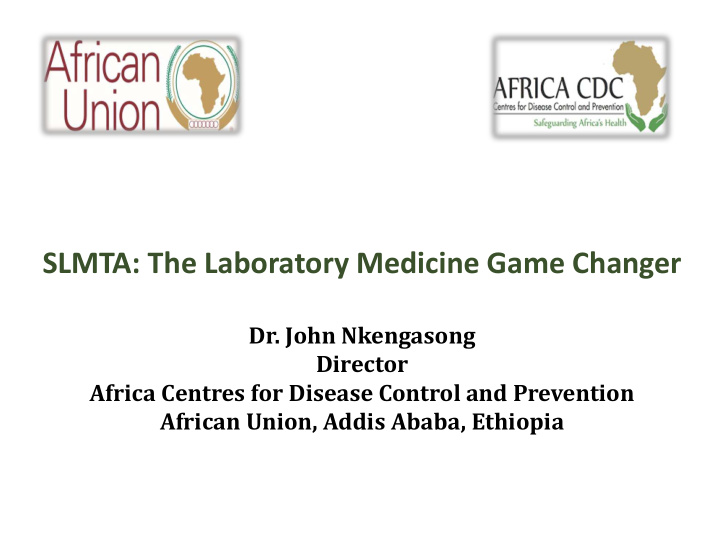



SLMTA: The Laboratory Medicine Game Changer Dr. John Nkengasong Director Africa Centres for Disease Control and Prevention African Union, Addis Ababa, Ethiopia
Humble Beginnings... Adwa Hospital Labatory After Before Awash Health Center Laboratories
Reference Laboratory - Early Days
Internationally Accredited Laboratories In Africa as of 2008 Public 30 9.7% 30 Sub-Saharan Africa 8% 28 28 312 282 Private 82.3% South Africa 92% n=340 n=312
Launch of the WHO AFRO Stepwise Laboratory Improvement Process Towards Accreditation, 2010
The Case for Lab Strengthening Neglected Lab Infrastructure
Institute Of Medicine Report on Evaluation of PEPFAR (2013) “Although challenges remain, the improvement of laboratories under PEPFAR support and guidance has been a signature achievement of the program ---- During the committee’s country visits, this was a theme emphasized with near universality”
Five Lessons Learned
Plan Improve Develop Quality Assurance Cycle Ensuring accurate patient results Corrective Implement Actions Monitor What gets Measured gets Done
Results of Laboratory Audits at Baseline and Exit (n=302) Baseline Exit 5 5 Stars Average Score 39% 64% 4 Stars 4 3 Stars 2 Stars 3 1 Star 0 Stars 2 1 30% 85% 0 Stars Note: Each square represents one laboratory Average Implementation Time = 16 months Define, Improve, Measure = Impact and Accountability Source: Yao et al. 2014 12
Produce in Africa and exported: SLMTA took off like a bullet Bahamas Jamaica Haiti Dominican Republic - St Kitts Belize - Antigua - Dominica - St Lucia Sierra - St Vincent Ethiopia Vietnam Leone - Grenada South Sudan Cambodia Guatemala Barbados Uganda Trinidad & Tobago Kenya Cote Ghana El Salvador Suriname Rwanda d’Ivoire Nigeria Burundi Honduras Cameroon Tanzania Democratic Republic of Congo Malawi Nicaragua Angola Mozambique Costa Rica Zambia Panama Zimbabwe Colombia Peru Namibia Botswana Swaziland South Africa Lesotho 2010-2013 Total Year when SLMTA was initiated: 2010 2011 2012 2013 # countries 47 # labs enrolled 617 # people trained 1,923 Source: Yao et al. 2014
SLMTA became a networking platform = produced a chain effect of people to people
Rising Sea Tides Lift all Boats: An Instrument for other health systems
“SLMTA is an invaluable tool for every lab director, every hospital manager and health policy maker because of its value in ensuring quality improvement within the laboratory and its potential in contributing to strengthening the entire health system at little or no cost.” (Director of a Regional Hospital in Cameroon)
“As quality improvements become institutionalised in hospital laboratories, it is becoming evident that entire hospital systems are in dire need of similar quality improvement programmes. The Namibia MoHSS calls on international agencies to develop and adapt programmes such as SLIPTA and SLMTA for use throughout hospital systems so as to ensure continuous quality patient care .”
SLMTA and SLIPTA brought out the best from us: Adult moment in the continuum of health systems
SLMTA in Action in Botswana Hi Sibongier- In Botswana on TBIC evaluation- saw notebook with SLMTA written on it- a lab at Palapaye Hospital keeping track of microscopy turn around times- they have been reduced from 3-5 days to reach surrounding clinics to 24 hours- based on their records and reports from clinics- go SLMTA! The lab is also calling clinics directly when they have a smear+ specimen. Cheers- Courtney
The Right Champion and Partnerships
Katy Yao - Champion’s Champion and Grandmother of SLMTA
Leadership and Commitment Strategic and Partnerships and Relationships
ASLM MISSION To advance professional laboratory medicine practice, science, systems and networks in Africa needed to support preventive medicine, quality care of patients and disease control through partnership with governments and relevant organizations . ADVANCING THE LABORATORY PROFESSION & NETWORK IN AFRICA
Meet the Ministers at ASLM Launch 2011
The Lancet March 2018 “ ----Together, SLMTA and SLIPTA have revolutionised laboratory improvement in LMICs. As the global community considers the call to action by Horton and colleagues,4 lessons learned from the past decade’s successes will be crucial in facilitating progress in the years ahead. Flagship programmes such as SLMTA and SLIPTA must continue to be supported and scaled up. Tools similar to SLMTA/SLIPTA could be developed to strengthen microbiological laboratories for antimicrobial resistance testing and testing of other diseases. It is important that vertical programmes such PEPFAR and the Global Fund continue to fund this programme--- ”
Conclusion Bigger, Bolder, Better
Thanks!
Recommend
More recommend